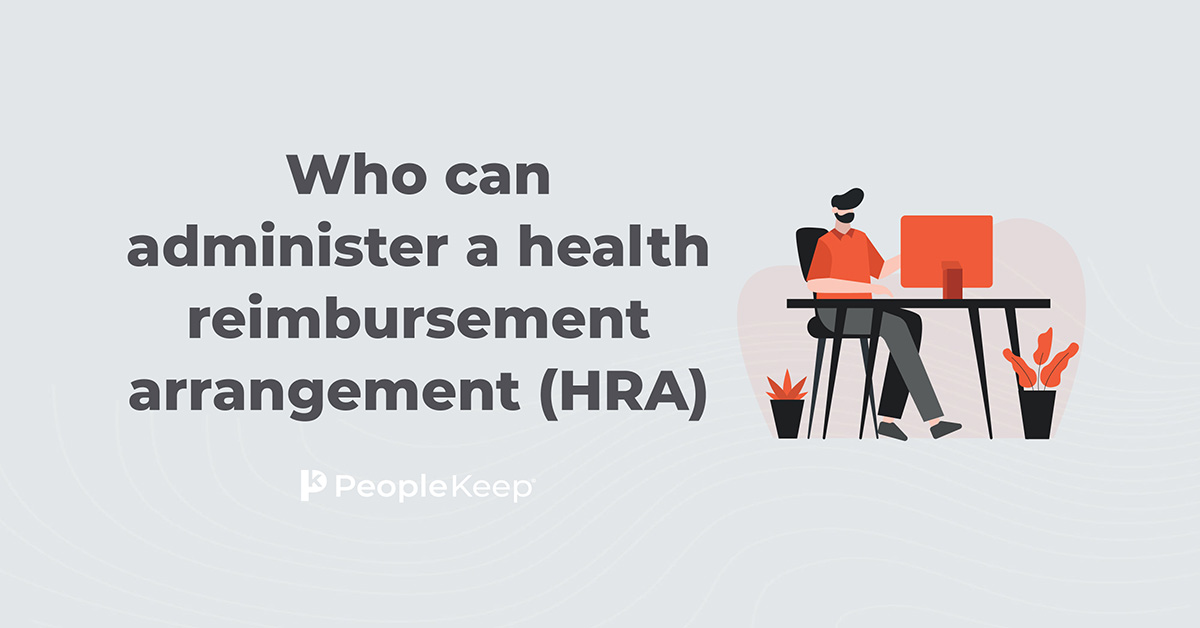Who Can Administer a Healthcare Reimbursement Plan?
By PeopleKeep Team on September 8, 2014 at 12:00 PM
Healthcare Reimbursement Plans provide small and medium sized businesses an affordable health benefits solution. A common question from business owners, HR professionals, CPAs, and brokers is "who can administer the Healthcare Reimbursement Plan?"
This article examines the basic rules of Healthcare Reimbursement Plans (HRPs) and who can administer the reimbursement plan in a compliant way.
Editor's note: PeopleKeep, formerly Zane Benefits, no longer supports the HRP. For information on newer health reimbursement arrangements (HRAs), see our guide.
How Do You Set Up a Healthcare Reimbursement Plan?
To set up a Healthcare Reimbursement Plan, employers should set up a formal plan to ensure compliance with the ACA, the IRS, HIPAA, and ERISA. A Healthcare Reimbursement Plan (HRP) is a type of Section 105 self-insured medical reimbursement plan designed for premium reimbursement. Employers often use an HRP as the foundation of "pure" defined contribution health benefits. An HRP is similar to a business expense account for personal health insurance.
Who Can Administer a Healthcare Reimbursement Plan?
For a business to administer a formal Healthcare Reimbursement Plan (one set up with an HRP), they need to have legal Plan Documents in place. The Plan Documents describe the plan's terms and conditions related to the operation and administration of the plan.
Since a Healthcare Reimbursement Plan is subject to ERISA, a legal plan document must be provided in writing. If a Healthcare Reimbursement Plan exists without a written Plan Document the business is out of compliance.
In addition to the Plan Document, a business needs to make sure they have certain safeguards in place to stay compliant with the IRS, ERISA, HIPAA, and ACA. This includes how the plan is set up and designed, and how the plan is administered.
Because of these compliance reasons, and for ease of use and time savings, virtually all businesses use a third party to administer the Healthcare Reimbursement Plan. There are three main options for compliant administration: a traditional third-party administrator ("TPA"), a Healthcare Reimbursement Software provider, or a consultant such as a CPA or Broker.
-
A Traditional TPA helps a business: set up the plan, create and distribute Plan Documents, manage all reimbursement funds, review claims for reimbursement, keep medical receipts on file, and issue reimbursements to employees. Traditional TPAs require pre-funding of the Healthcare allowances and may have limited plan design options and limited online access.
-
A Healthcare Reimbursement Software Provider helps a business: set up the plan, create and distribute Plan Documents electronically, provide a "quickbooks-like" tracking of reimbursement funds, review claims for reimbursement, keep medical receipts on file electronically, and notify the employer (through the software) when to reimburse employees via payroll. Healthcare Reimbursement Software does not require pre-funding of allowances, and is not a fiduciary.
-
A CPA or Broker helps a business: set up the plan, create and distribute Plan Documents, review claims for reimbursement, keep medical receipts on file, and may manage all reimbursement funds and issue reimbursements to employees. CPAs or Brokers often help companies run these plans "on the side" and administration can be time-consuming. Many CPA's or Brokers end up partnering with a Healthcare Reimbursement Software provider for easier administration of the plan and more flexibility in plan design.
The other way businesses occasionally administer a Healthcare Reimbursement Plan is by self-administration.
-
Self-Administration: Technically, a business can self-administer its own Section 105 Healthcare Reimbursement Plan, but failure to comply with the minimum federal and ACA administration requirements is common without utilizing proper Healthcare Reimbursement Software or a TPA. Businesses that self-administer are frequently out of compliance with ERISA, HIPAA, COBRA, and ACA regulations, and businesses can face costly fines for being out of compliance. And, if a business puts into place all of the safeguards needed for compliance, the administrative cost likely outweighs the benefits of the Healthcare Reimbursement Plan.
Healthcare Reimbursement Plan Compliance
So, what are the compliance requirements discussed above?
1. Tax Savings & IRS Compliance: The IRS requires that a formal Healthcare Reimbursement Plan (with Section 105 Plan Documents) be established in order for reimbursements to be tax-deductible for the employer, and pre-tax for employees.
2. Federal Compliance: The federal government has guidelines for employers who want to contribute to employee's IRS-qualified medical expenses:
-
HIPAA (Medical Privacy): Employees’ medical information needs to be kept HIPAA-protected, and all medical documentation stored in compliance with HIPAA for 10 years, as required by the IRS for audit purposes. Employers should never see employees’ medical information, including the details of their premium expense, to stay HIPAA compliant and stay nondiscriminatory.
-
ERISA: Under ERISA, employers are not allowed to “endorse” a specific individual health insurance plan. When offering a Healthcare Reimbursement Plan, the employer should not know the details of individual health insurance plans purchased by employees. They should only know that it is a qualified medical expense allowed by the plan.
3. ACA/Health Care Reform: The Affordable Care Act (ACA) introduced new requirements for Healthcare Reimbursement Plans including how benefit information is presented to employees (Summary of Benefits & Coverage, or SBC), new reporting forms (720/5500) and new plan design requirements including compliance with PHS 2711 (prohibition on annual limits) and PHS 2713 (preventive care).
Check out more resources
See these related articles

Who can administer a health reimbursement arrangement (HRA)?
Want to know who can administer a health reimbursement arrangement (HRA)? Find out the requirements and guidelines for establishing an HRA here.

Why Health Insurance Brokers Need An HRA Administration Partner
Why Every Health Insurance Broker Should Have An HRA Administration Partner Health Reimbursement Accounts and Arrangements.

What is healthcare reimbursement?
Looking to reimburse your employees for their healthcare expenses? Learn everything you need to know about healthcare reimbursement.


